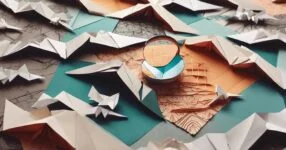The pros of technology are improved communication through digital platforms like video chats and social networks. It boosts business efficiency by simplifying processes and enabling effective marketing strategies.
The cons of technology are potential job shortages as machines replace human labor. The financial burden of keeping up with technological advancements can be significant, alongside increased privacy risks due to extensive data collection.
Technology Fact Sheet: Internet Access, Social Media, and Automation
- Internet Access: 5.18 billion global users in 2023; two-thirds of the population online.
- Social Media: Daily usage rose from 90 minutes in 2012 to over 3 hours by 2020.
- Automation and Jobs: Human task hours to drop 13% by 2022; 20 million manufacturing jobs at risk from robots by 2030; 400-800 million individuals may need new jobs by 2030 due to automation.
- Device Shipments: 68 million desktops and 214 million notebooks expected to be shipped by 2023 and 2027, respectively.
- Digital Marketing: 63% of businesses increased digital marketing budgets recently; 14% spending growth from 2020 to 2021.
- Remote Work: 12.7% of full-time employees working from home in 2023; 28.2% in hybrid model.
- E-commerce: Sales grew from 15% of total retail in 2019 to 22% in 2021.
- Internet usage worldwide – statistics & facts | Statista.
- How Many People Have Access To The Internet? Internet Statistics 2023.
- 20+ Automation & Job Loss Statistics for 2024 | Fortunly.
- Global personal computing devices shipments 2027 | Statista.
- 180+ Powerful Digital Marketing Statistics for 2024 – WordStream.
- Global Ecommerce Growth Forecast 2022 | Morgan Stanley.
- Facts and Figures 2023 – Internet use.
- 167+ Internet Statistics, Trends and Facts [Mobile Included].

Key Takeaways:
- Technology boosts human well-being and democratizes knowledge by providing comfort, convenience, and quick access to information.
- It revolutionizes communication by breaking distance barriers, enabling people to connect more easily.
- In business, technology drives increased efficiency, growth, and productivity.
| Pros of Technology | Cons of Technology |
|---|---|
| Enhances well-being | Addiction risk |
| Comfort and convenience | Ethical dilemmas |
| Quick information access | Social isolation |
| Facilitates online learning | Environmental damage |
| Breaks communication barriers | Privacy risks |
| Improves business efficiency | Dependency increase |
| Boosts digital marketing | Decreased learning effort |
| Streamlines communication | Reduced self-reliance |
| Automates tasks | Skill loss risk |
| Boosts productivity | Replaces human jobs |
| Frees up time | Safety risks |
| Accelerates daily activities | Requires constant maintenance |
| Speeds decision-making | High cost barriers |
| Instant information access | Economic barriers |
| Facilitates remote work | Unequal benefits distribution |
| Overcomes geographical barriers | Job shortage risk |
| Various communication channels | Affordability issues |
| Real-time collaboration | Privacy breaches |
| Facilitates idea sharing | Unwanted marketing |
| Enhances accessibility | System failure risks |
| Prevents cyber-attacks | Technological malfunction costs |
| Protects from cyber threats | Impact on traditional industries |
| Strengthens security | Reduced interpersonal skills |
| Encourages secure practices | GPS over-reliance |
| Enhances global understanding | Sedentary lifestyle risks |
Pros of Technology

- Enhances human well-being: Technology significantly improves the quality of life by providing solutions for health, comfort, and accessibility. Medical advancements such as telemedicine and digital health monitoring allow for more immediate and personalized care, enhancing the overall well-being of individuals globally.
- Provides comfort and convenience: From smart homes that adjust temperature and lighting to suit one’s preferences to apps that streamline daily activities, technology has made life more comfortable and convenient. Innovations in technology have transformed mundane tasks, making them easier and less time-consuming.
- Democratizes quick access to information: With over 5.18 billion global internet users, the internet has made it possible for a vast majority of the global population to access an unprecedented amount of information swiftly. This has democratized learning and the acquisition of knowledge, breaking down barriers that once existed due to distance or socioeconomic status.
- Facilitates learning with online courses: The proliferation of online courses and digital educational resources has transformed how we learn, providing opportunities for lifelong learning beyond traditional classrooms. This shift has made education more accessible and flexible, accommodating different learning styles and schedules.
- Breaks distance barriers in communication: Technology has obliterated the constraints of geographical distance, enabling people to communicate instantly across the world. Services like video conferencing and instant messaging allow individuals and businesses to maintain relationships and collaborate regardless of location.
- Improves business process efficiency: The integration of technology in business processes has streamlined operations, reducing manual effort and leading to more efficient workflows. From automation of mundane tasks to AI-driven analytics, technology supports businesses in being more productive and competitive.
- Enables digital and social media marketing for business growth: The 14% growth in digital marketing spending between 2020 and 2021 signifies how critical technology has become for business promotion. Platforms like Facebook and Google offer targeted advertising capabilities that have revolutionized how businesses reach and engage with consumers.
- Streamlines communication, coordination, and task implementation: Project management tools and collaboration platforms enable teams to work together seamlessly, regardless of their physical locations. This coordination has led to improved productivity and the ability to manage complex tasks with ease.
- Automates manual tasks, saving time and effort: With the expected drop of human task hours by 13% by 2022, automation technologies like robotics in manufacturing are increasingly taking over repetitive and labor-intensive tasks. This not only saves time but also allows human workers to focus on more complex and rewarding work.
- Boosts productivity and task completion speed: Technology accelerates various aspects of work, from data processing to complex problem-solving, resulting in increased productivity and faster task completion. This speed is essential in a fast-paced world where time-to-market can be a competitive advantage.
- Frees up time for other important activities: As automation and efficient technologies take over routine tasks, people have more time to engage in creative activities, spend with family, or pursue personal growth, contributing to a more balanced and fulfilling life.
- Accelerates cooking, cleaning, working, and commuting activities: Household chores and daily tasks are made quicker with the help of technology, from smart kitchen appliances that speed up cooking to navigation apps that find the fastest commuting routes, technology enhances the efficiency of daily life.
- Speeds up information exchange and decision-making: The instantaneous nature of digital communication has accelerated the exchange of information, facilitating quicker decision-making in both personal and professional contexts. This rapid exchange is critical in dynamic environments that require prompt responses.
- Provides instant access to information and resources: The vast repository of information available online ensures that anyone with internet access can find answers to questions, learn new skills, and access a wide array of resources instantly, fostering a more informed and educated society.
- Facilitates remote work, saving commuting time: With 12.7% of full-time employees working from home and 28.2% engaging in hybrid work models, technology has made remote work a reality, saving countless hours that would otherwise be spent on commuting.
- Overcomes geographical barriers in communication: The global nature of the internet and digital communication platforms means that individuals and businesses can maintain relationships and operations across continents as if they were in the same room.
- Offers various communication channels like email and video conferencing: The diversity of communication tools available, including email, video calls, instant messaging, and social media, caters to various needs and preferences, enhancing personal and business communication.
- Enables real-time communication and collaboration: Technology supports immediate interaction and collaboration among individuals, which is crucial for both social connections and professional teamwork, leading to more cohesive and synchronized efforts in various endeavors.
- Facilitates idea and knowledge sharing across platforms: Social media and collaborative platforms have become hubs for sharing ideas, knowledge, and creativity, contributing to collective intelligence and the rapid spread of innovation across different fields.
- Enhances accessibility and inclusivity for diverse communication needs: Assistive technologies and adaptive devices provide individuals with disabilities the means to communicate effectively and access information, promoting inclusivity and equal opportunities for all.
- AI algorithms detect and prevent cyber-attacks: The development of sophisticated AI algorithms has enhanced cybersecurity, helping to detect and prevent potential attacks, thus protecting individuals and organizations from the increasing threats in the digital world.
- Protects sensitive information and resources from cyber threats: Technology plays a crucial role in safeguarding sensitive data and digital resources, with encryption and security protocols becoming more advanced to counteract evolving cyber threats.
- Strengthens security against unauthorized access and data breaches: With the implementation of robust security measures, technology ensures that private information and corporate data are shielded from unauthorized access, maintaining privacy and integrity.
- Encourages secure system and practice development: The focus on technology security has led to the development of more secure systems and best practices, which are essential in building trust and reliability in digital interactions and transactions.
- Enhances global connectivity and understanding: The global network enabled by technology not only connects people but also fosters a better understanding among different cultures and communities, contributing to a more cohesive and empathetic world society.
Cons of Technology

- May lead to technology addiction: The increase in daily social media usage to over 3 hours suggests a potential for addiction, where users become excessively reliant on digital platforms for social interaction and entertainment, which can lead to negative impacts on mental health and well-being.
- Raises ethical dilemmas with AI and robotics: The advancement of AI and robotics presents complex ethical challenges, such as the proper use of autonomous systems and the moral implications of AI decisions. These dilemmas require careful consideration and the development of new ethical frameworks.
- Can cause dehumanization and social isolation: Despite enhancing connectivity, technology can also lead to social isolation as individuals replace face-to-face interactions with digital communication. This can result in a sense of dehumanization where personal connections become less tangible and meaningful.
- Contributes to pollution and environmental damage: The production and disposal of technological devices contribute to environmental degradation. As the demand for new devices grows, so does the ecological footprint of the tech industry, leading to pollution and resource depletion.
- Poses privacy and security risks: The widespread use of technology and the internet has heightened concerns about privacy and security, with personal information often being vulnerable to unauthorized access and cyber-attacks, despite efforts to enhance cybersecurity.
- Increases dependency on technology for tasks: With more tasks becoming automated, there is an increasing dependency on technology to perform daily activities. This dependency raises concerns about what would happen if these systems fail and how capable individuals are of managing without technological assistance.
- Decreases effort in learning due to reliance on technology: The ease of finding information online can lead to a decrease in the effort put into learning and understanding complex concepts deeply. The instant gratification of quick searches might undermine the development of critical thinking and in-depth learning skills.
- Impacts self-reliance and problem-solving skills: Over-reliance on technology can erode problem-solving skills and self-reliance. As devices become more intuitive and capable, there’s a risk that individuals may lose the ability or the inclination to perform tasks or solve problems on their own.
- Risks losing skills due to over-dependence: The displacement of jobs by robots and the expected transition of up to 800 million individuals to new jobs due to automation underscores the risk of skills becoming obsolete. Workers must constantly adapt and retrain to stay relevant in the changing job market.
- Replaces human jobs with machines and algorithms: The potential for 20 million manufacturing jobs to be displaced by robots by 2030 highlights the stark reality that machines and algorithms are replacing human labor, which can lead to unemployment and economic disruption.
- Causes potential safety risks and malfunctions: Technological malfunctions can pose significant safety risks, especially when it comes to autonomous vehicles, medical devices, or other critical systems where human lives might be at stake if technology fails.
- Requires constant monitoring and maintenance: Technology systems necessitate ongoing maintenance and updates to function correctly and securely. This need for constant monitoring can be resource-intensive and may divert attention from other essential tasks or operations.
- High costs make some technologies inaccessible: Advanced technologies often come with high costs, making them inaccessible to certain segments of the population. This technological divide can exacerbate existing inequalities and hinder inclusive growth.
- Economic barriers limit technological advancement for some groups: The distribution of technological benefits is often unequal due to economic barriers, which can prevent lower-income individuals and communities from accessing the latest technological innovations.
- Unequal technological benefits distribution due to cost: The costs associated with new technologies mean that not everyone can benefit from them equally. This inequality can lead to a divide where only those who can afford it have access to the latest and most efficient technology.
- Leads to a shortage of jobs due to increased task efficiency: The expected reduction in human task hours by 13% by 2022 due to automation implies that fewer human workers are needed for certain tasks, potentially leading to job shortages in various sectors.
- Some technologies are expensive and not affordable for all: With millions of computing devices shipped each year, the cost of staying up-to-date with the latest technology can be prohibitive for many, leading to a digital divide where less affluent individuals may not have access to these tools.
- Devices may collect data without user knowledge, leading to privacy breaches: The connectivity and intelligence of modern devices often come with the risk of data collection without explicit user consent, posing significant privacy concerns.
- Unwanted marketing and personal information sharing without consent: The growth in digital marketing raises concerns about the extent to which personal information is shared without consent, as businesses seek to leverage user data for targeted advertising.
- Minor malfunctions can lead to complete system failures: The interconnected nature of modern technologies means that even minor issues can cascade into complete system failures, with potentially widespread and serious consequences.
- Costly consequences of technological malfunctions: When technology systems fail, the consequences can be expensive, not just in terms of financial costs for repairs and replacements but also in lost productivity and trust.
- Potential negative impact on traditional industries and professions: The rapid growth of e-commerce and digital platforms can have a detrimental impact on traditional retail and other industries, leading to job losses and the decline of established practices.
- May reduce face-to-face socialization and interpersonal skills: With a significant percentage of employees working remotely or in hybrid models, there’s a risk that opportunities for in-person socialization and the development of interpersonal skills may diminish.
- Risk of over-reliance on GPS and digital navigation tools: As reliance on GPS and digital navigation tools increases, there is a risk that individuals’ ability to navigate independently or read traditional maps may deteriorate, potentially leaving them helpless if digital tools fail.
- Can lead to a sedentary lifestyle due to convenience and automation: The convenience and automation provided by technology can contribute to a sedentary lifestyle, as many tasks can be performed without leaving one’s desk or home, which can have adverse effects on physical health.
Benefits of Technology and Digital Transformation
Technology significantly enhances productivity, communication, and information access, benefiting individuals and society.
Digital transformation has streamlined and facilitated work and life processes.
Enhanced cybersecurity measures offer increased online security, safeguarding sensitive information and resources.
Artificial intelligence and machine learning improve various life aspects, from personalized services to autonomous vehicles, boosting decision-making efficiency.
Furthermore, advancements in data privacy grant greater personal information control, with stricter regulations and advanced encryption fostering confidence in online interactions and transactions.
Additionally, technology plays a crucial role in environmental monitoring and weather prediction, helping to mitigate natural disasters and plan agricultural activities.

Challenges With Technology
- Technology Addiction: Increased reliance on technology, including smartphones and social media, can lead to addiction, affecting mental health and disrupting daily life.
- Digital Divide: Unequal access to technology creates a divide, limiting opportunities and hindering progress for marginalized communities.
- Privacy Concerns: Advancements in technology raise issues about personal data protection and privacy, with concerns over data breaches and surveillance.
- Ethical AI: The development of artificial intelligence poses ethical questions, including job displacement, biases in AI, and autonomous decision-making.
- Tech Regulations: The rapid growth of technology necessitates effective regulations to address data privacy, cybersecurity, and potential misuse.
Impact on Communication
Technology has significantly enhanced communication by removing geographical barriers, enabling real-time collaboration, and revolutionizing education with online access. Social media allows global connections and idea sharing, while the Internet of Things and smart devices offer seamless device connectivity and remote control. Assistive technologies have improved inclusivity in communication for individuals with disabilities. However, despite these advancements, maintaining face-to-face interactions is essential for preserving human connections and interpersonal skills.
Technology in Business

- Technology in Business: Revolutionizes operations with digital marketing and increased efficiency. For example, a small business can use social media platforms to reach a wider audience cost-effectively, while a multinational corporation might employ advanced data analytics to optimize its supply chain.
- E-commerce Growth: Facilitates global transactions and market expansion through online platforms and digital payments. A local artisan can sell their products worldwide via an e-commerce site, while consumers enjoy the convenience of shopping from home and making secure online payments.
- Cloud Computing: Offers remote data access, reduces physical storage needs, and enhances security and flexibility. A startup can leverage cloud services to access high computing power without investing in expensive hardware, and a healthcare provider might use cloud storage to securely manage patient records.
- Digital Marketing: Transforms marketing with cost-effective, measurable strategies like social media, SEO, and email marketing. A restaurant could use targeted Facebook ads to attract local customers, while an e-commerce company might employ SEO strategies to increase its visibility in search engine results.
- Software Development: Enables businesses to automate and streamline operations with custom software solutions, improving efficiency and focus on core activities. A retail store might use inventory management software to track stock levels accurately, while a service-based company could use CRM software to enhance customer engagement and satisfaction.
Future and Responsibility With Modern Technology

As technology rapidly evolves, society faces the responsibility of managing its challenges and harnessing its opportunities.
The rise of remote work technology offers flexibility and work-life balance but also brings concerns about job displacement and the necessity of upskilling.
Green technology emerges as a critical solution for combating climate change, emphasizing the need for sustainable development. Policy-making in technology, addressing privacy, security, and data protection, is vital for balancing innovation with responsibility.
Ultimately, the future of technology depends on informed, ethical decisions and awareness of its societal impacts, guiding us towards maximizing its benefits and securing a better future for all.













